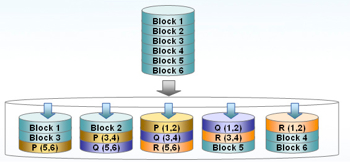Case description
customers reported to us that their HUAWEI OceanStor Dorado storage system RAID-TP failed, resulting in data loss, hoping to help them recover data.

Solution
1. Case assessment
1) Introduction to RAID-TP
RAID (redundant independent disk array) is a storage technology used to improve data reliability and performance. Among them, RAID-TP is a relatively new RAID level, especially designed for flash memory storage systems. Based on RAID-6, it adds a check disk to achieve a higher level of data protection. The RAID-TP array consists of three parts: data disk, verification disk, and conversion disk:
data Disk: a data disk is a disk that stores primary data;
verification disk: the verification disk is used to store the verification information of the data in the data disk. If the data disk is damaged, the verification disk can be used to recover the data;
conversion disk: The conversion disk is used to store the conversion information between the data disk and the verification disk to improve the efficiency of data recovery.
2) working principle of RAID-TP
data write: when data is written to RAID-TP array, data is split into multiple blocks, which are evenly written to each data disk. At the same time, the system verifies these data blocks, generates verification information, and writes the verification information to the verification disk. In addition, the system generates conversion information based on data blocks and verification information, and writes the conversion information to the conversion disk;
data reading: When reading data, the system reads data blocks from the data disk, and then obtains verification information from the verification disk based on the conversion information to verify whether the read data is correct.

2. Recovery plan
huawei OceanStor Dorado V6 storage system adopts dynamic RAID technology to implement redundancy design, providing different protection levels according to the number of test bits in RAID. The storage system provides three protection levels: RAID 5, RAID 6, and RAID-TP. RAID-TP the data recovery process of automatic verification. If the data disk is damaged, the system can perform the following steps to recover the data:
1) the system first reads the verification information from the verification disk, and then calculates the damaged data block according to the conversion information;
2) The system then writes the recovered data blocks to the new data disk to complete the data recovery.
Currently, there is no data recovery software that can support RAID-TP. You can customize RAID recombination according to the following structure:

case Summary
huawei OceanStor Dorado V6 storage system adopts dynamic RAID reconstruction technology (also called indentation reconstruction technology), and the reconstruction granularity is CK. That is, the total number of available hard disks in the storage pool is smaller than the number of RAID member disks. During downsizing and refactoring, the M (check column) is kept unchanged, and the N (data column) is reduced, the number of RAID check columns remains unchanged and the number of data columns decreases before and after reconstruction. After refactoring, the number of RAID group members decreases, but the RAID redundancy level remains unchanged. After the faulty disk is replaced, the system adds N (data column) based on the number of available hard disks in the storage pool, and new data is written in a RAID mode, data written during a failure is gradually converted to a new RAID mode.


 Reprint
Reprint 